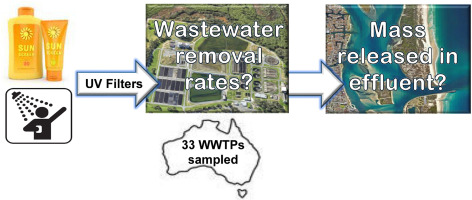当前位置:
X-MOL 学术
›
Chemosphere
›
论文详情
Our official English website, www.x-mol.net, welcomes your feedback! (Note: you will need to create a separate account there.)
Annual release of selected UV filters via effluent from wastewater treatment plants in Australia.
Chemosphere ( IF 8.8 ) Pub Date : 2020-01-10 , DOI: 10.1016/j.chemosphere.2020.125887 Elissa O'Malley 1 , Jake W O'Brien 1 , Rory Verhagen 1 , Jochen F Mueller 1
Chemosphere ( IF 8.8 ) Pub Date : 2020-01-10 , DOI: 10.1016/j.chemosphere.2020.125887 Elissa O'Malley 1 , Jake W O'Brien 1 , Rory Verhagen 1 , Jochen F Mueller 1
Affiliation

|
Studies conducted globally have identified wastewater effluent as a key source of UV filters released into the aquatic environment. We assessed the annual release of UV filters from wastewater treatment plant effluent in Australia and evaluated the removal of these chemicals during wastewater treatment. Effluent samples were collected from 33 sites alongside matching influent samples. Sample collection predominately occurred during the Australian Census in August 2016, which allowed for accurate per capita normalisation of the results. A subset of sites was also sampled over the Southern Hemisphere summer (December-February) period. Five UV filters were detected with at least one detected in 95% of effluent samples. The summed concentration of UV filters ranged from 130 ng L-1 to 8400 ng L-1 and averaged 2800 (±1900) ng L-1. Of the target UV filters, 2-phenylbenzimidazole-5-sulfonic acid (PBSA) and benzophenone 4 (BP4) showed the lowest removal efficiencies (11 ± 36% and 51 ± 43%, respectively) across all sites and were the most abundant in effluent. Average estimated removal efficiencies of the other compounds were between 59 (±24) % (4-methylbenzylidene camphor (4-MBC)) and 74 (±22) % (benzophenone 1 (BP1)). We did not find a trend in seasonal differences in the per capita release of UV filters in effluent samples. We estimate that approximately 40% of UV filter loads measured in influent are breaking through to the effluent resulting in the release of approximately 20 kg day-1 of the selected UV filters into the aquatic environment from treated wastewater effluent in Australia.
中文翻译:

每年通过澳大利亚废水处理厂的废水释放选定的紫外线过滤器。
全球范围内进行的研究已将废水确定为释放到水生环境中的紫外线滤光片的主要来源。我们评估了澳大利亚废水处理厂废水中紫外线过滤器的年排放量,并评估了废水处理过程中这些化学物质的去除情况。从33个地点收集了污水样品,并配上了匹配的污水样品。样本收集主要发生在2016年8月的澳大利亚人口普查期间,这使结果的人均准确归一化。在南半球的夏季(12月至2月)期间也对一部分站点进行了采样。检测到五个紫外线过滤器,其中至少有一个在95%的废水样品中检测到。紫外线滤光片的总浓度范围为130 ng L-1至8400 ng L-1,平均为2800(±1900)ng L-1。在目标紫外线滤光片中,在所有位置上2-苯基苯并咪唑-5-磺酸(PBSA)和二苯甲酮4(BP4)的去除效率最低(分别为11±36%和51±43%),并且在废水。其他化合物的平均估计去除效率在59(±24)%(4-甲基亚苄基樟脑(4-MBC))和74(±22)%(二苯甲酮1(BP1))之间。我们没有发现废水样品中人均释放紫外线过滤剂的季节差异趋势。我们估计,在进水中测得的UV过滤器负载中约有40%渗透到废水中,导致澳大利亚处理过的废水中约有20 kg day-1的选定UV过滤器释放到水生环境中。2-苯基苯并咪唑-5-磺酸(PBSA)和二苯甲酮4(BP4)在所有位置上的去除效率最低(分别为11±36%和51±43%),并且出水量最多。其他化合物的平均估计去除效率在59(±24)%(4-甲基亚苄基樟脑(4-MBC))和74(±22)%(二苯甲酮1(BP1))之间。我们没有发现废水样品中人均释放紫外线过滤剂的季节差异趋势。我们估计,在进水中测得的UV过滤器负载中约有40%渗透到废水中,导致澳大利亚处理过的废水中约有20 kg day-1的选定UV过滤器释放到水生环境中。2-苯基苯并咪唑-5-磺酸(PBSA)和二苯甲酮4(BP4)在所有位置上的去除效率最低(分别为11±36%和51±43%),并且出水量最多。其他化合物的平均估计去除效率在59(±24)%(4-甲基亚苄基樟脑(4-MBC))和74(±22)%(二苯甲酮1(BP1))之间。我们没有发现废水样品中人均释放紫外线过滤剂的季节差异趋势。我们估计,在进水中测得的UV过滤器负载中约有40%渗透到废水中,导致澳大利亚处理过的废水中约有20 kg day-1的选定UV过滤器释放到水生环境中。分别)分布在所有站点上,并且废水量最多。其他化合物的平均估计去除效率在59(±24)%(4-甲基亚苄基樟脑(4-MBC))和74(±22)%(二苯甲酮1(BP1))之间。我们没有发现废水样品中人均释放紫外线过滤剂的季节差异趋势。我们估计,进水中测得的UV过滤器负载中约有40%渗透到废水中,导致澳大利亚处理过的废水中约有20 kg day-1的选定UV过滤器释放到水生环境中。分别)分布在所有站点上,并且废水量最多。其他化合物的平均估计去除效率在59(±24)%(4-甲基亚苄基樟脑(4-MBC))和74(±22)%(二苯甲酮1(BP1))之间。我们没有发现废水样品中人均释放紫外线过滤剂的季节差异趋势。我们估计,在进水中测得的UV过滤器负载中约有40%渗透到废水中,导致澳大利亚处理过的废水中约有20 kg day-1的选定UV过滤器释放到水生环境中。我们没有发现废水样品中人均释放紫外线过滤剂的季节差异趋势。我们估计,在进水中测得的UV过滤器负载中约有40%渗透到废水中,导致澳大利亚处理过的废水中约有20 kg day-1的选定UV过滤器释放到水生环境中。我们没有发现废水样品中人均释放紫外线过滤剂的季节差异趋势。我们估计,在进水中测得的UV过滤器负载中约有40%渗透到废水中,导致澳大利亚处理过的废水中约有20 kg day-1的选定UV过滤器释放到水生环境中。
更新日期:2020-01-11
中文翻译:

每年通过澳大利亚废水处理厂的废水释放选定的紫外线过滤器。
全球范围内进行的研究已将废水确定为释放到水生环境中的紫外线滤光片的主要来源。我们评估了澳大利亚废水处理厂废水中紫外线过滤器的年排放量,并评估了废水处理过程中这些化学物质的去除情况。从33个地点收集了污水样品,并配上了匹配的污水样品。样本收集主要发生在2016年8月的澳大利亚人口普查期间,这使结果的人均准确归一化。在南半球的夏季(12月至2月)期间也对一部分站点进行了采样。检测到五个紫外线过滤器,其中至少有一个在95%的废水样品中检测到。紫外线滤光片的总浓度范围为130 ng L-1至8400 ng L-1,平均为2800(±1900)ng L-1。在目标紫外线滤光片中,在所有位置上2-苯基苯并咪唑-5-磺酸(PBSA)和二苯甲酮4(BP4)的去除效率最低(分别为11±36%和51±43%),并且在废水。其他化合物的平均估计去除效率在59(±24)%(4-甲基亚苄基樟脑(4-MBC))和74(±22)%(二苯甲酮1(BP1))之间。我们没有发现废水样品中人均释放紫外线过滤剂的季节差异趋势。我们估计,在进水中测得的UV过滤器负载中约有40%渗透到废水中,导致澳大利亚处理过的废水中约有20 kg day-1的选定UV过滤器释放到水生环境中。2-苯基苯并咪唑-5-磺酸(PBSA)和二苯甲酮4(BP4)在所有位置上的去除效率最低(分别为11±36%和51±43%),并且出水量最多。其他化合物的平均估计去除效率在59(±24)%(4-甲基亚苄基樟脑(4-MBC))和74(±22)%(二苯甲酮1(BP1))之间。我们没有发现废水样品中人均释放紫外线过滤剂的季节差异趋势。我们估计,在进水中测得的UV过滤器负载中约有40%渗透到废水中,导致澳大利亚处理过的废水中约有20 kg day-1的选定UV过滤器释放到水生环境中。2-苯基苯并咪唑-5-磺酸(PBSA)和二苯甲酮4(BP4)在所有位置上的去除效率最低(分别为11±36%和51±43%),并且出水量最多。其他化合物的平均估计去除效率在59(±24)%(4-甲基亚苄基樟脑(4-MBC))和74(±22)%(二苯甲酮1(BP1))之间。我们没有发现废水样品中人均释放紫外线过滤剂的季节差异趋势。我们估计,在进水中测得的UV过滤器负载中约有40%渗透到废水中,导致澳大利亚处理过的废水中约有20 kg day-1的选定UV过滤器释放到水生环境中。分别)分布在所有站点上,并且废水量最多。其他化合物的平均估计去除效率在59(±24)%(4-甲基亚苄基樟脑(4-MBC))和74(±22)%(二苯甲酮1(BP1))之间。我们没有发现废水样品中人均释放紫外线过滤剂的季节差异趋势。我们估计,进水中测得的UV过滤器负载中约有40%渗透到废水中,导致澳大利亚处理过的废水中约有20 kg day-1的选定UV过滤器释放到水生环境中。分别)分布在所有站点上,并且废水量最多。其他化合物的平均估计去除效率在59(±24)%(4-甲基亚苄基樟脑(4-MBC))和74(±22)%(二苯甲酮1(BP1))之间。我们没有发现废水样品中人均释放紫外线过滤剂的季节差异趋势。我们估计,在进水中测得的UV过滤器负载中约有40%渗透到废水中,导致澳大利亚处理过的废水中约有20 kg day-1的选定UV过滤器释放到水生环境中。我们没有发现废水样品中人均释放紫外线过滤剂的季节差异趋势。我们估计,在进水中测得的UV过滤器负载中约有40%渗透到废水中,导致澳大利亚处理过的废水中约有20 kg day-1的选定UV过滤器释放到水生环境中。我们没有发现废水样品中人均释放紫外线过滤剂的季节差异趋势。我们估计,在进水中测得的UV过滤器负载中约有40%渗透到废水中,导致澳大利亚处理过的废水中约有20 kg day-1的选定UV过滤器释放到水生环境中。



























 京公网安备 11010802027423号
京公网安备 11010802027423号